|
Egypt Media Center
Hotel/Cruise Reviews:
Hiding Away in Egypt
Slideshows:
Busy, Bustling Cairo
Cruising the Nile & Exploring Luxor
Relaxing in Style at the Red Sea
Videos:
To view all our videos, subscribe to our YouTube channel.
Know How
Best times to travel: Egypt's high season generally runs from November through mid-April, when the weather is coolest. We traveled in mid-May and though it was hot, sometimes above 100° F, it was a dry heat and really not objectionable.
Entry: Americans and most Europeans do not need pre-arranged visas. The visa that is required can be purchased at immigration on entry for $15.
Language: Most Egyptians dealing with tourists speak English, and so do the more educated in urban areas. Egyptians do respond to people who try to learn some of the basics of Arabic, not the easiest of languages to pick up.
Getting Around: Egypt and especially Cairo are best experienced on an organized group tour or by hiring a private driver/guide. Flights from Cairo to Aswan, Luxor, and Hurghada are relatively frequent, and internal airfares are not expensive, usually under $100 for these one-to-two-hour flights. Our car/driver for a private transfer between Luxor and the Red Sea cost about $130 for a four-hour trip.
Clothing: Most tourism venues are casual. Dress for touring should be light, comfortable, and reflective (white and beiges). Good, comfortable shoes and hats are essential. Evenings can be cool, especially in winter, so plan on light sweaters or jackets. Evening attire can be a bit dressier, especially at top-end hotels and resorts. Egyptians don't wear shorts, so doing so is not recommended except at resorts and for shore excursions while cruising the Nile.
Money: The Egyptian pound trades at about six to the U.S. dollar. You should bring more cash than usual or plan on getting cash at ATMs along the way, as street vendors and even many shops do not take credit cards. ATMs are relatively plentiful in the larger cities. U.S. dollars are not as welcome as we expected, and you might not do well on the exchange rate when buying from local vendors, but they are acceptable in a pinch. I'd take along lots of smaller denomination bills in case you run out of Egyptian pounds.
I was surprised my bank now hits me with the 3% fee for drawing money from my own checking account at ATMs internationally. I call it "The Bank Traveler's Tax." You may be better off carrying traveler's checks or even cash and exchanging it at your hotel or a local bank.
Shopping/Bargaining: Crafts—inlaid boxes, game boards, brass and stone works, etc.—are a good deal in Egypt. So are textiles, especially cotton. International luxury goods can be a good buy. With street vendors and small shops, you should always bargain and bargain hard. We found we could usually get things at a third to a quarter of what was originally asked.
Eating/Dining: Egyptian food is very Mediterranean, spicy but healthy. Portions are generally large. We ate mostly in hotels and on the ship but also in some local restaurants. We ate everything with no reservations and were never sick beyond a mild touch of Montezuma's—or in this case, Tutankhamun's—revenge.
Why Go Now?
Here are five good reasons to put Egypt on your "visit now" list, and they all relate to the fact that there's almost no one traveling there currently. Tourism represents about 10% of Egypt's GNP and employment, and overall it has suffered about a 50% decline. So read on, then call Hideaways Travel Services (800-843-4433) to take advantage of some great travel deals in Egypt.
- Lodgings are a bargain: Our Nile cruise ship was only one-third full! Cairo's Mena House and The Oberoi Sahl Hasheesh on the Red Sea were also at about 30-40 % capacity. There are deals to be had—just ask for them.
- Shopping is a bargain: We actually felt sorry for the vendors of local wares, memorabilia, and even services. They seemed almost desperate. Everything is always negotiable, and right now things are very negotiable.
- No lines, no waiting! We were shocked to learn that in normal times and during high season, some 300-plus cruise ships would be plying the Nile, all stopping at the same places we were. We saw a few ships on the water. That's all. The rest were there but parked along the Nile's banks. We did not have to queue to see any of the sights or deal with any crowds. That's not normal during better times.
- Witness the revolution: There's a new sense of freedom in the air in Egypt, and you can see and feel it in the populace. It's not often you get the chance to experience a country being reborn. By traveling there now, you'll be showing your support for Egypt's new-found freedom.
- Security is high: Especially at four- and five-star hotels, staff search incoming vehicles and screen all visitors with metal detectors and baggage with x-ray machines—much like in India after the Mumbai terrorist incidents. We've heard of no such problems or animosity toward foreign visitors, and we had no problems during our visit. Quite the opposite. We were welcomed with open arms by the man in the street and all people associated with tourism, especially when they discovered we were Americans.
|
Why should it be on your list? For starters, the Pyramids of Giza are the only wonders of the ancient world still in existence. And they are only the beginning of the ancient wonders and mysteries Egypt has to reveal to you. Then there's the shopping—lots of deals on art, handicrafts, and more—and the historic Nile River, one of the cradles of civilization. Finally, Egypt has the Red Sea with its fabulous snorkeling, diving, fishing, and sybaritic resorts. But I'm getting ahead of myself.
We first started contemplating a trip to Egypt last November. Little did we know that, between then and our scheduled mid-May visit, the country would undergo a tumultuous revolution. As our go/don't-go day of decision approached, we evaluated. The media was full of stories about protests and some violence. It always is. The State Department offered foreboding warnings. They always do. But our local contacts said all was fine except for the occasional minor demonstration in downtown Cairo. We went with the local insight, rolling the dice on who was right. Besides, visiting a place that is in the midst of radical change adds a little spice to the adventure. It's not often you get to experience a country that has just overthrown the despots and is in the process of reinventing itself. Think America in 1776!
I'm not going to give you a blow-by-blow of our trip. Instead, I'm going to tell you how we planned it—because I think we really got it right—then give you the highlights and our reactions to what we saw, felt, and learned.
The Grand Plan
We figured ten days was about right for experiencing Egypt. Depending on your penchant for Egyptology and ancient civilizations, and your available time, you could easily stay longer. We planned three elements to our Egyptian experience: Cairo, a Nile cruise, and a visit to the Red Sea. We planned them in that sequence, too, figuring we would start with the most active and work our way to the most relaxing. The only down side of going in that sequence is that the best shopping is in Cairo, and I prefer to leave my shopping to last, having more opportunities to evaluate options and comparison shop, and fewer goodies to lug along on the rest of the trip.
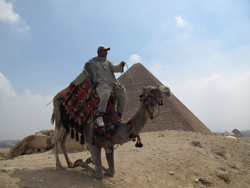 Because we were traveling from a city with no direct flights to Cairo, we would have to make at least one stop. We decided to stop in Europe, specifically Amsterdam, and break up the outbound journey with a two-day layover. That was a great decision—otherwise the trip would have been quite long, and a stay in cool, civilized, watery, liberal Amsterdam contrasted magnificently with what we would experience in hot, dusty, and frenetic Cairo. You could stop off in other destinations depending on your gateway city—Paris, London, Rome, even Istanbul. A good travel agent can help you decide. Because we were traveling from a city with no direct flights to Cairo, we would have to make at least one stop. We decided to stop in Europe, specifically Amsterdam, and break up the outbound journey with a two-day layover. That was a great decision—otherwise the trip would have been quite long, and a stay in cool, civilized, watery, liberal Amsterdam contrasted magnificently with what we would experience in hot, dusty, and frenetic Cairo. You could stop off in other destinations depending on your gateway city—Paris, London, Rome, even Istanbul. A good travel agent can help you decide.
Cairo at Warp Speed
I'd been to Cairo before, so I thought I knew what to expect. But in the 35-plus years since my first visit, Cairo has boomed to an estimated 20 million people, as big as Mexico City or NYC. It is huge, congested, and, did I mention, dusty and frenetic. The traffic and driving are unbelievable—total bedlam! You need eyes on all sides of your head and a very calm temperament to deal with it. It's best not to deal with it at all; get a hotel transfer from the airport and then do your city touring with an organized group. Or, better yet, hire a private car, driver, and guide, which is what we did.
The most surprising and disappointing aspect of Cairo's boom is that it has jumped the Nile, absorbed Giza, and spread around one side of the Great Pyramids and beyond. When I visited before, once you crossed the Nile you were in verdant farm country passing through quaint villages on your way to the Pyramids, which stood pretty much on their own surrounded by desert. The fact that a city encroaches on one side of these stunning monuments—the other side is still desert—definitely impacts their allure.
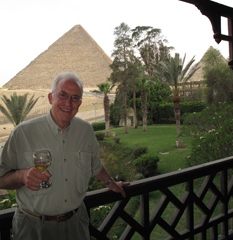 Regardless, the Pyramids are still a spectacular sight, and there is no better place from which to appreciate them than the legendary Mena House Oberoi, part of the wonderful India-based Oberoi Group of hotels. Originally a hunting lodge for the king, it became a hotel in 1886 and since then has been home to celebrities, politicos, itinerant writers, and discerning travelers desiring a ringside seat to the Pyramids. It is set in its own lush 40-acre compound, with accommodations in two sections: the old and very atmospheric palace, the centerpiece of the hotel, and the more modern wing overlooking beautiful gardens and a magnificent swimming pool. Regardless, the Pyramids are still a spectacular sight, and there is no better place from which to appreciate them than the legendary Mena House Oberoi, part of the wonderful India-based Oberoi Group of hotels. Originally a hunting lodge for the king, it became a hotel in 1886 and since then has been home to celebrities, politicos, itinerant writers, and discerning travelers desiring a ringside seat to the Pyramids. It is set in its own lush 40-acre compound, with accommodations in two sections: the old and very atmospheric palace, the centerpiece of the hotel, and the more modern wing overlooking beautiful gardens and a magnificent swimming pool.
The palace is certainly the more interesting of the two lodgings, though we judged it to be in need of renovation, which we were told is scheduled to occur. Spacious rooms and suites on one side, most with balconies, look out directly to the Pyramid of Cheops. While we were there, the full moon was rising over the Pyramids—a special bonus. Public rooms offer palatial arabesque spaces. Just walking the halls of the Mena House, with its collection of black-and-white photos of both ordinary and famous visitors over its long life, is a stroll through time. In fact, a wonderful 90-page book has been published that chronicles the hotel's history.
The newer wing of the hotel offers modern garden- and pool-view rooms, and rooms with a more distant but still-great view of the pyramids over the oasis-like compound. The palace offers two dining venues, one typically Egyptian and the other with Indian-themed cuisine. The hotel offers many other distractions and services, including a full spa.
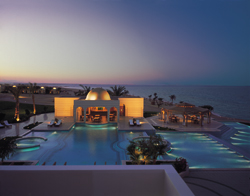 We took two days to explore Cairo, but could have used another day to do it more at ease. Our visit was a bit untypical—a quick look at the Sphinx and Pyramids to snap some photos, then off to Cairo proper to visit the ancient Khan El Khalili crafts market, followed by lunch at the Naguib Mahfouz Café, a delightful restaurant run by Oberoi. It offers an Arabic atmosphere with waiters in vintage Egyptian attire, plus good service and excellent cuisine. Be forewarned: If you eat like the Egyptians, it is quite an affair, with multiple courses and large portions. We took two days to explore Cairo, but could have used another day to do it more at ease. Our visit was a bit untypical—a quick look at the Sphinx and Pyramids to snap some photos, then off to Cairo proper to visit the ancient Khan El Khalili crafts market, followed by lunch at the Naguib Mahfouz Café, a delightful restaurant run by Oberoi. It offers an Arabic atmosphere with waiters in vintage Egyptian attire, plus good service and excellent cuisine. Be forewarned: If you eat like the Egyptians, it is quite an affair, with multiple courses and large portions.
Of course, we had to visit Tahrir Square to see ground zero of Egypt's freedom movement. Actually, it's more like a big, bustling, not very attractive traffic circle. A small demonstration—drums beating and flags waving—was organizing and parading along the street while we were there. On one side of the square, one of the new commercial ventures is the sale of colorful Egyptian, Palestinian, and other Middle Eastern flags.
Our final stop of the day was the famous Egyptian Museum, with the most extensive collection of pharaonic antiquities in the world. An Egyptologist could spend a day or more here. For us, a couple of hours were fine, with the most impressive sight being the Tutankhamun exhibit. Frankly, I think the museum could use a face-lift, some better interpretation of exhibits, and certainly better lighting. The building itself is quite dark and mausoleum-like.
A side note: It would have paid to have done some research on ancient Egyptian history in order to appreciate all we were told at the museum and for the next week on our visits to various temples and sites along the Nile. If you don't have the "big picture" and an appreciation for how all that history fits together, I think the details and stories you get from guides tend to go in one ear and out the other.
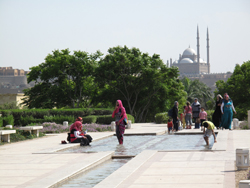 Our second day in Cairo was spent strolling the grounds of the massive Citadel, the ancient walled compound high on a massif that was the original city. Inside was the massive Ottoman-style Mohamed Ali Mosque, built by and named for one of Egypt's most revered rulers in the early 19th century. From the Citadel's grounds, you can see all of Cairo stretched out in every direction and even the Pyramids of Giza in the hazy distance. Our second day in Cairo was spent strolling the grounds of the massive Citadel, the ancient walled compound high on a massif that was the original city. Inside was the massive Ottoman-style Mohamed Ali Mosque, built by and named for one of Egypt's most revered rulers in the early 19th century. From the Citadel's grounds, you can see all of Cairo stretched out in every direction and even the Pyramids of Giza in the hazy distance.
That afternoon we had a relaxing lunch with our guide at a delightful al fresco restaurant overlooking the lush Al Azhar Park, one of the few green spaces in Cairo, from high ground adjacent to the Citadel. It was fun watching Egyptian families at their leisure, young ladies hiking their galabeyas to their knees and wading in the cool reflecting pools, families picnicking and playing in the shady corners of the gardens.
I should mention that along the way, we met many Cairo natives and were uniformly greeted with curiosity and open arms. Most speak at least some English, and the typical conversation went something like: "Where are you from? England?" "No, America, the United States." "America--Ah! Welcome! You like Egypt?"
Call of the Nile
Most Nile cruises run between Aswan, with its famous dam, and Luxor to the north (downstream) or vice versa, taking from three to seven days. You can easily fly from Cairo to either city in little more than an hour. Cruising distances between stops at ancient temples and sites along the way are not long, and most sailing is done during daylight hours. One massive lock needs to be negotiated between the two cities, roughly halfway in between.
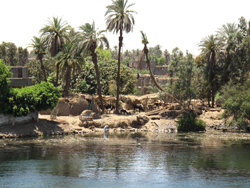 The cruise we chose was on the Philae, the older and more traditional of two ships run by Oberoi, which does the voyage in four days. Their other ship, the Zahra, is ultra-modern and very elegant, and does more leisurely seven-day trips. We chose to travel from Aswan to Luxor, primarily because I felt Luxor would be more interesting than Aswan and I wanted to end the voyage on a crescendo. Also, Luxor is within driving distance of the Red Sea for the last leg of our adventure. The cruise we chose was on the Philae, the older and more traditional of two ships run by Oberoi, which does the voyage in four days. Their other ship, the Zahra, is ultra-modern and very elegant, and does more leisurely seven-day trips. We chose to travel from Aswan to Luxor, primarily because I felt Luxor would be more interesting than Aswan and I wanted to end the voyage on a crescendo. Also, Luxor is within driving distance of the Red Sea for the last leg of our adventure.
The cruise made one or two stops for shore excursions each day, with guides traveling aboard to explain the various temples and sights along the way. Groups were small, just 10 to 12 people. As I had expected, Luxor, with its Valley of the Kings—a mountainous burial site where they are still turning up new finds—plus the imposing twin statues of the Colossi of Memnon, the massive Temple of Karnak, and its Avenue of the Sphinx, made it the most impressive of all the places we visited in our four days on the Nile.
My fondest memories of the cruise, however, are those of relaxing on the top deck of the Philae, sipping a "sundowner" while peacefully floating down the Nile, its banks lush with date palms and verdant farms, as workers rode their donkeys or camels along the river. Occasionally, we'd pass a village and see children swimming. Beyond that lushness and vibrant country life stretched rolling orange and yellow hills and escarpments—desert as far as the eye could see. At sunset, always spectacular, the melodic call of the muazzin from the minarets of the many mosques along the Nile's banks was simply mesmerizing.
Cruising the Nile allowed me to scratch one adventure off my "Life List." Interestingly, though, the list didn't get any shorter. Now I want to cruise all the world's major rivers, including our own Mississippi.
Relaxing at the Red Sea
If you live in North America, you probably wouldn't visit the Red Sea for sun and fun. It's just too far, and we have lots of other alternatives. But if you're already in Egypt, it makes for the perfect relaxing end to an otherwise history- and culture-crammed vacation. Rather than fly back through Cairo, we hired a car and driver to take us from Luxor to Hurghada, a hot and only modestly interesting four-hour trip. The first part of the drive, south through towns and farms bordering the Nile, was quite beautiful and interesting, but the last three hours through hard rock desert were interrupted only briefly by a somewhat dramatic mountain range as we approached the Red Sea.
Hurghada is Egypt's version of Cancun. A small fishing village not long ago, it has blossomed into a major international resort complete with airport, well-paved thoroughfares, shopping malls, and myriad restaurants and bars appealing to the area's mostly European and Russian clientele. I'm told there are some 1,200 hotels lining it 23 miles of shoreline, most budget all-inclusives. The difference between it and Cancun? Among other things, buildings are not high-rise and the sand is not as beautiful as the Riviera Maya's.
As I said, if you're already in Egypt I would certainly recommend a visit here, but only to one of its more upscale resorts—and there is none better than The Oberoi Sahl Hasheesh at the very southern and more-refined end of Hurghada's strip development. Once we pulled into this luxe, 48-acre private oasis, we didn't budge for three days. That's unheard of for us, as we usually like to explore a destination thoroughly. But The Oberoi Sahl Hasheesh was nirvana; just 102 luxurious suites in modern Moorish-style villas and a palatial central lodge, all scattered around acres of manicured, oasis-like desert landscaping, and fronting on the beach and the indigo Red Sea.
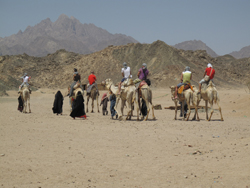 Here was everything we needed to recover from all the touring we'd just done and the mind-boggling cornucopia of ancient history we had tried to absorb: space to spread out, excellent restaurants in beautiful venues, big azure pools—including a private pool in the Royal Suite we were upgraded to—a really nice spa, an attractive though not very swimmable beach, close-in reefs with prolific coral and fish life, great service throughout the resort, and best of all, peace and quiet. Here was everything we needed to recover from all the touring we'd just done and the mind-boggling cornucopia of ancient history we had tried to absorb: space to spread out, excellent restaurants in beautiful venues, big azure pools—including a private pool in the Royal Suite we were upgraded to—a really nice spa, an attractive though not very swimmable beach, close-in reefs with prolific coral and fish life, great service throughout the resort, and best of all, peace and quiet.
I was stunned by the variety of fish I saw just snorkeling from the resort's dock, at least 50 different species. In fact, I was so satisfied with this experience I didn't bother to try the scuba diving offered by the resort's own dive center.
The spa and its very experienced Thai attendants were terrific, so much so that we ended up doing a different treatment each day. Each day also featured a special event hosted by the resort and complimentary to guests. The first evening it was a lecture on astronomy and the constellations by a local expert who brought along her high-powered, high-tech telescope to observe the stars and Saturn's rings. The next day it was a lesson in creating sand art in a bottle. It sounds hokey but was actually pretty interesting, and the instructor was very patient with us klutzes. The next day it was a yoga lesson.
The biggest treat, however, was having time to recoup and reflect on all we had seen and done to this point, and to spend some down time together. Al fresco breakfasts looking out over the blue, blue sea and dinners under the starry Arabian sky were most romantic. And for the pièce de résistance, our last evening we ordered up a private dinner in a very secluded beachfront setting, followed by a private screening of a classic vintage movie—just the two of us under waving date palms by the melodic sea, and the twinkling lights of distant hotels and resorts along the shore. The perfect end to a perfect trip!
|